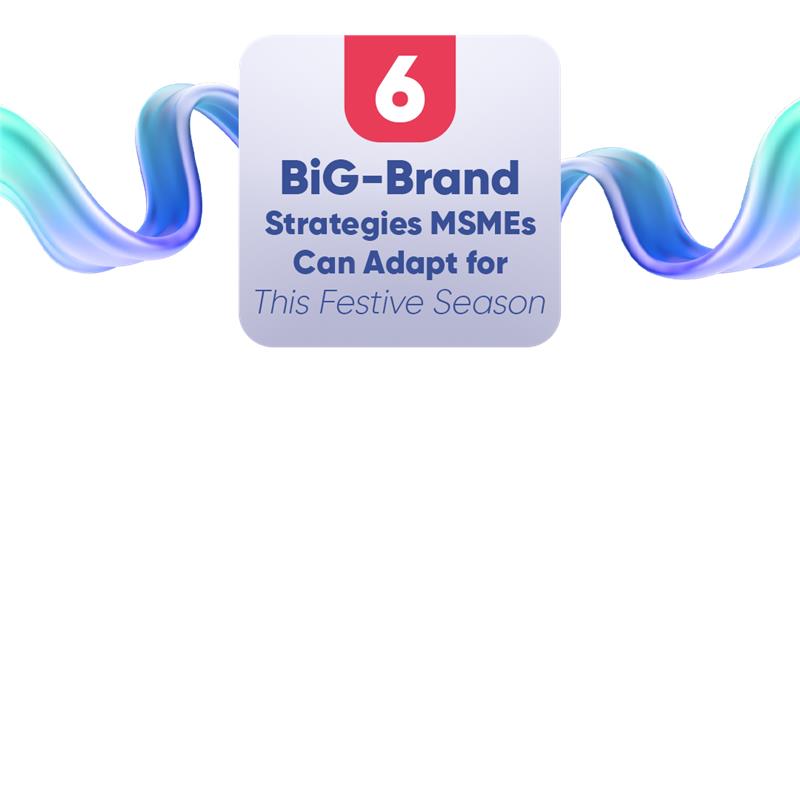6 Big‑Brand Strategies MSMEs Can Adapt for Profitability This Festive Season
- Online order volumes in the 2025 pre‑festive season grew 19% year‑on‑year, led by strong Tier‑2 and Tier‑3 market demand.
- Large brands enter with planned campaigns, strong inventory, and significant marketing spends to capture festive demand.
- MSMEs, despite resource constraints, can adapt big‑brand strategies with smart planning and execution.
- Strategies include: Creating a strong visual identity and regional culture connect, effective inventory management, pricing and promoting strategically with combo deals and festive discounts, being discoverable online, and enhancing customer experience with personal touches and clear communication.
- Loans from RBI-registered NBFCs like Protium can help small enterprises prepare for the season with confidence
E‑commerce companies and consumer brands entered the festive pre‑season of 2025 with strong momentum. Between July 11–14, online order volumes grew 19% year‑on‑year, mainly driven by demand for electronics, appliances, and fashion. While metro cities saw a respectable 15% rise, the real surge came from Tier‑2 and Tier‑3 markets, where orders jumped 21% and 22%, respectively, compared to 2024. Some brands even recorded sales spikes of up to eight times during this short period, signaling the buying power in smaller cities.
This surge is set against a wider industry backdrop where India’s retail sector is projected to accelerate from around 5% growth to 9–10% in 2025. Rising consumer confidence, increasing discretionary spending, and expanding demand from non‑metro regions are driving this momentum.
For MSMEs, this is a clear signal that the upcoming festive season will be fiercely competitive, with demand increasingly concentrated in regional markets. The challenge is not about whether customers are ready to buy, but about how prepared MSMEs are to capture that demand.
Large brands will approach the season with well-planned campaigns, robust inventory and supply chains, and significant marketing spends. The festive period offers an unmatched opportunity for MSMEs, too, but it also results in significant operational challenges. While MSMEs are known for their agility and ability to adapt to customer needs, they often face constraints in resources, financing, and reach. However, the season’s success is not just a big‑budget game. With smart planning, sharp execution, and learning from big brands’ strategies, MSMEs can position themselves to thrive during this high‑demand period.
The key lies in adapting the strategies smartly, cost-effectively, and locally. Here’s how
1. Branding & Visibility: Think Like a Brand, Act Like a Local
Large brands thrive on recognition. Their visual identity—logos, colors, packaging, and consistent storytelling—creates instant recall in a crowded market. Whether in a metro store or a small-town outlet, their brand presence feels familiar and trustworthy.
What MSMEs Can Do
MSMEs can build similar trust by strengthening their visual and cultural presence. Here’s what MSMEs can do:
- Enhance visual identity: Focusing on product photography, upgrading packaging, and maintaining a consistent logo across platforms can elevate a small business’s image. Affordable design tools make it possible to design professional festive creatives without high design costs.
- Add local flavor: Incorporating regional languages and familiar cultural motifs in festive marketing connects emotionally with customers in Tier-2 and Tier-3 cities. This could be as simple as festive greetings in local dialects on packaging, or storytelling that reflects community traditions.
- Utilize low-cost digital platforms: WhatsApp Business and social media reels allow MSMEs to share product showcases, customer testimonials, and behind-the-scenes preparation stories. Leveraging user-generated content—such as customers sharing their purchases—can further boost visibility and trust without heavy ad spending.
2. Inventory Management Planned Well & in Advance
Big brands rarely wait until the festive rush to prepare. Using sales data and predictive analytics, they boost production well in advance, often by 10–20%, and focus on best-selling products. They also streamline offerings to prioritize fast-moving items, reducing the risk of stockpiling slow sellers.
What MSMEs Can Do
For MSMEs, adopting even basic planning can make a significant difference.
- Maintain a Simple Inventory Tracker: A spreadsheet or using affordable inventory software helps identify which products sell fastest during past festive periods. This insight can guide stocking decisions, reducing the risk of shortages or overproduction.
- Raw material procurement: This is another area where early action matters. Securing supplies ahead of the peak season not only prevents last-minute price hikes but also ensures uninterrupted production. For businesses anticipating higher demand but facing cash constraints, business loans from an RBI-registered NBFC like Protium can bridge the gap between production and sales.
- Leverage AI‑Enabled Tools: Affordable AI tools and platforms can analyze past sales data, seasonal demand patterns, and local market trends to forecast product demand more accurately. These AI-enabled tools help MSMEs decide optimal stock levels, identify fast‑moving items in advance, and avoid both overstocking and stock‑outs. Some even integrate with e‑commerce platforms, enabling real‑time inventory tracking across sales channels.
3. Strategic Pricing & Promotions
Festive offers are not just about cutting prices, but about creating urgency and perceived value. Large brands carefully structure discounts, bundle deals, and timed promotions to encourage purchases. They may also offer early access sales, loyalty rewards, or flexible payment options like “buy now, pay later.”
What MSMEs Can Do
- Designing Combo Packs & Discounts: MSMEs can replicate big brands’ strategy on a smaller scale by designing combo packs, early-bird discounts, or limited-edition festive products. For example, a sweets shop could bundle multiple varieties in a single festive box at a slightly discounted price, or a clothing retailer could offer a free accessory with select purchases.
- Balance Promotions with Profitability: Pricing must be competitive but sustainable. Aligning offers with specific local festivals—such as Onam in Kerala or Navratri in Gujarat—can help build urgency and relevance, prompting faster customer decisions.
- Coupons: Offer coupons that customers can use for their next purpose. This ensures customers come back after the festive season, thereby steady sales throughout the year.
4. Delivering Unparalleled Customer Experience
Big brands invest heavily in ensuring that each order meets customer expectations—right from packaging to delivery and after-sales service. They use technology to personalize recommendations, manage customer service efficiently, and maintain seamless experiences across channels.
What MSMEs Can Do
MSMEs may not have such advanced systems, but they can still deliver memorable customer experiences.
- Small Gestures: Handwritten thank-you notes, festive-themed packaging, or small freebies—can turn a purchase into a positive memory.
- Communication: This also plays a crucial role. Responding promptly to customer queries on WhatsApp and clearly stating delivery timelines builds trust.
- Flexibility: Offering flexible delivery schedules or convenient payment methods for repeat customers strengthens loyalty, encouraging them to return beyond the festive period.
5. Digital Presence: Be Discoverable, Even Without a Website
In today’s festive marketplace, visibility often begins online. Large brands invest in search engine optimization (SEO), influencer partnerships, and paid advertising to maintain top-of-mind presence.
What MSMEs Can Do
MSMEs, even without a dedicated website, can achieve strong discoverability through free or low-cost platforms.
- Google Business Profile: Creating this ensures the business appears in local searches and maps.
- Social media: Create catalogs and short-form videos to showcase products and drive direct orders. Collaborations with local micro-influencers, who often charge far less than national influencers, can expand reach to highly relevant audiences.
- Tie-up with E-commerce platforms: MSMEs must tie up with several e-commerce or quick commerce platforms so they get orders online and offline. This ensures they are tapping into different customer personas.
6. Financing to Grow, Not Just to Survive
Big brands approach festive seasons with structured financing, using allocated budgets to scale marketing, inventory, and distribution. They plan cash flow months in advance, ensuring they can seize every sales opportunity.
What MSMEs Can Do
MSMEs can take a similar approach by viewing festive financing as a growth investment rather than just an emergency expense.
Loans from RBI-Registered NBFCs: Even modest loans can fund critical upgrades, whether in inventory, packaging, or delivery capabilities, that directly impact festive sales. Several lenders offer MSME-focused festive loans or credit lines. Protium, for instance, provides business loans and top-up loan options that can help small enterprises prepare for the season with confidence.
Festive success is not about matching the marketing budgets of big brands. It is about thinking like a brand, acting like a local, and delivering value that resonates deeply with customers.

